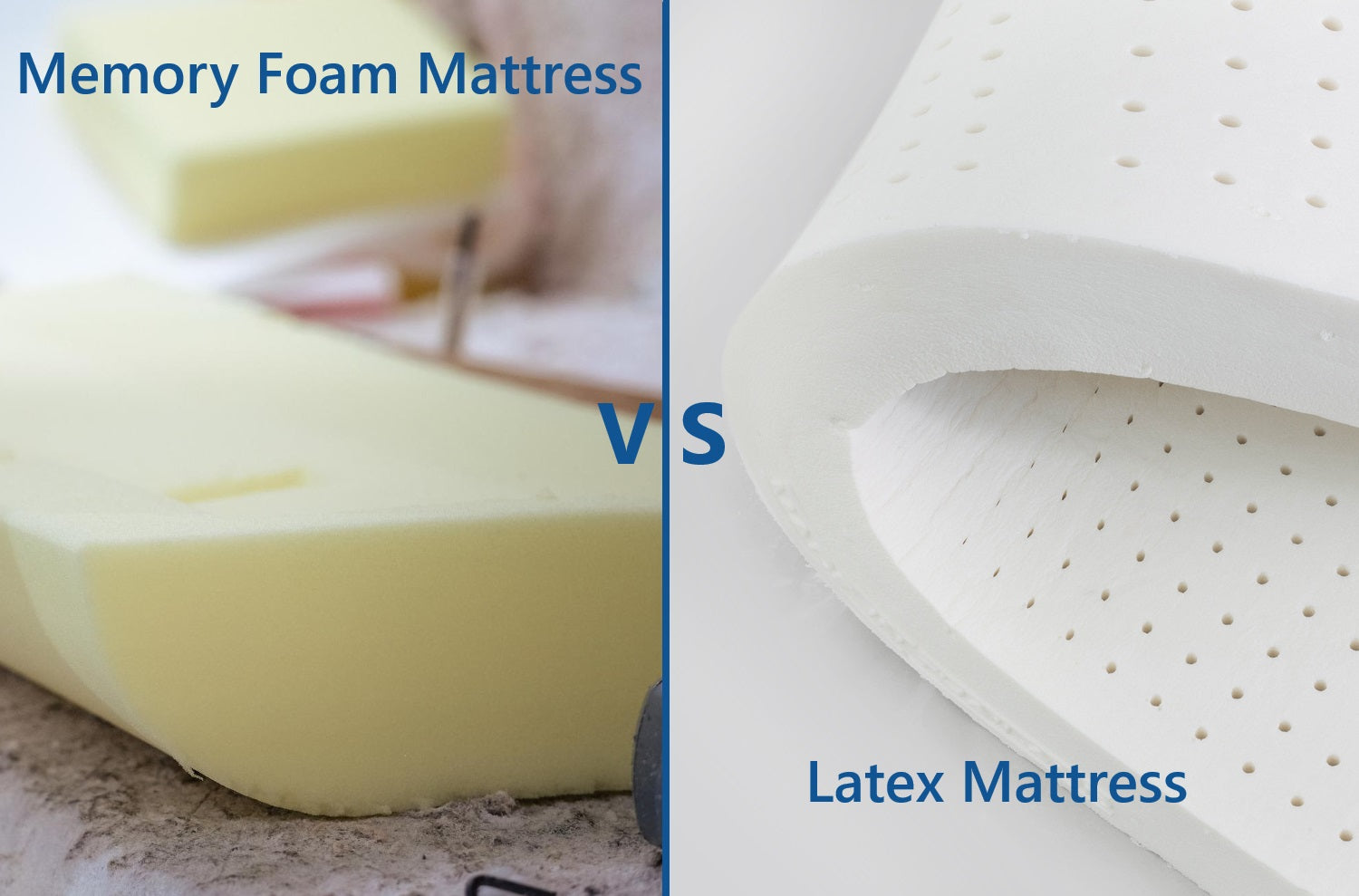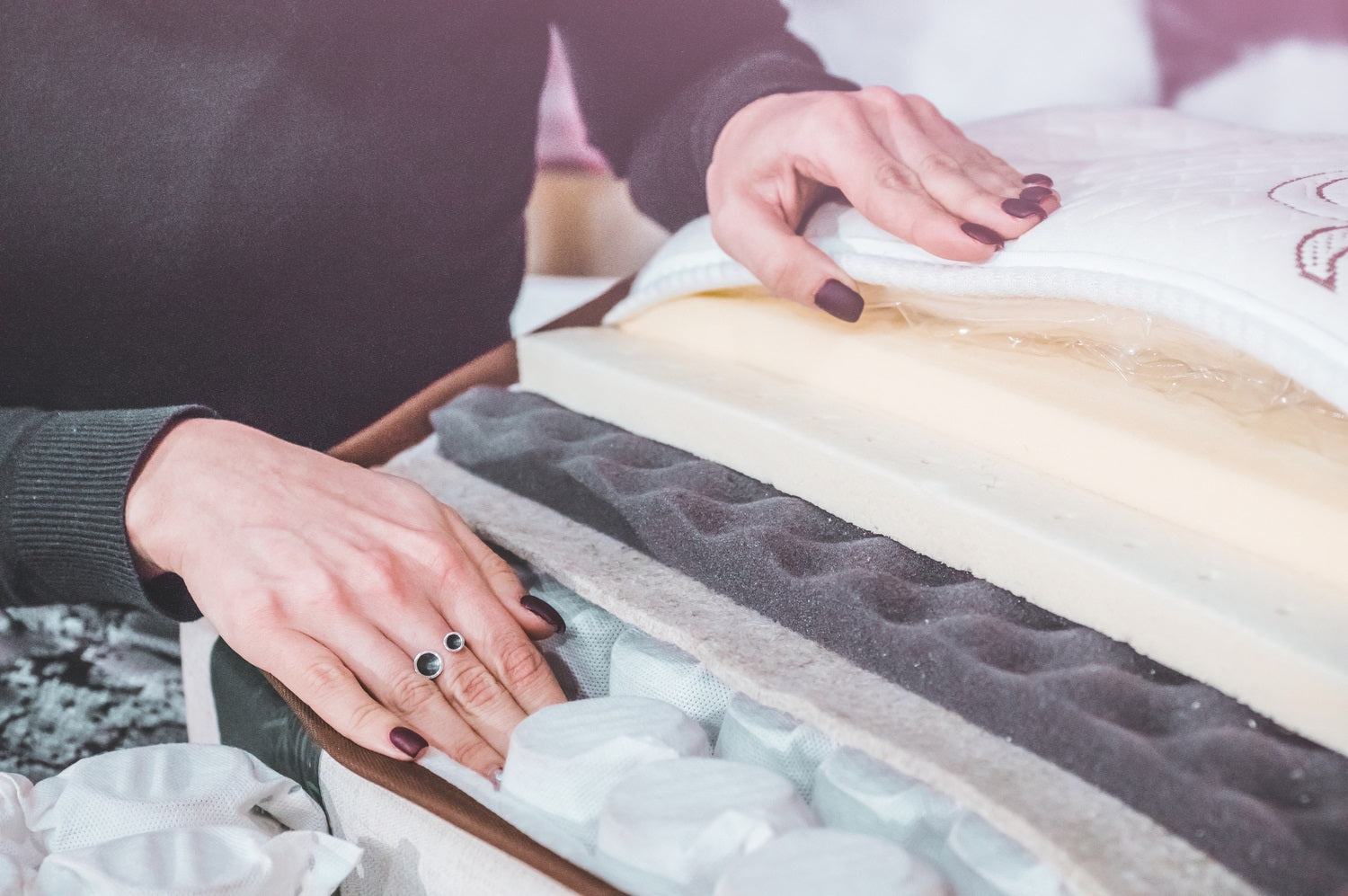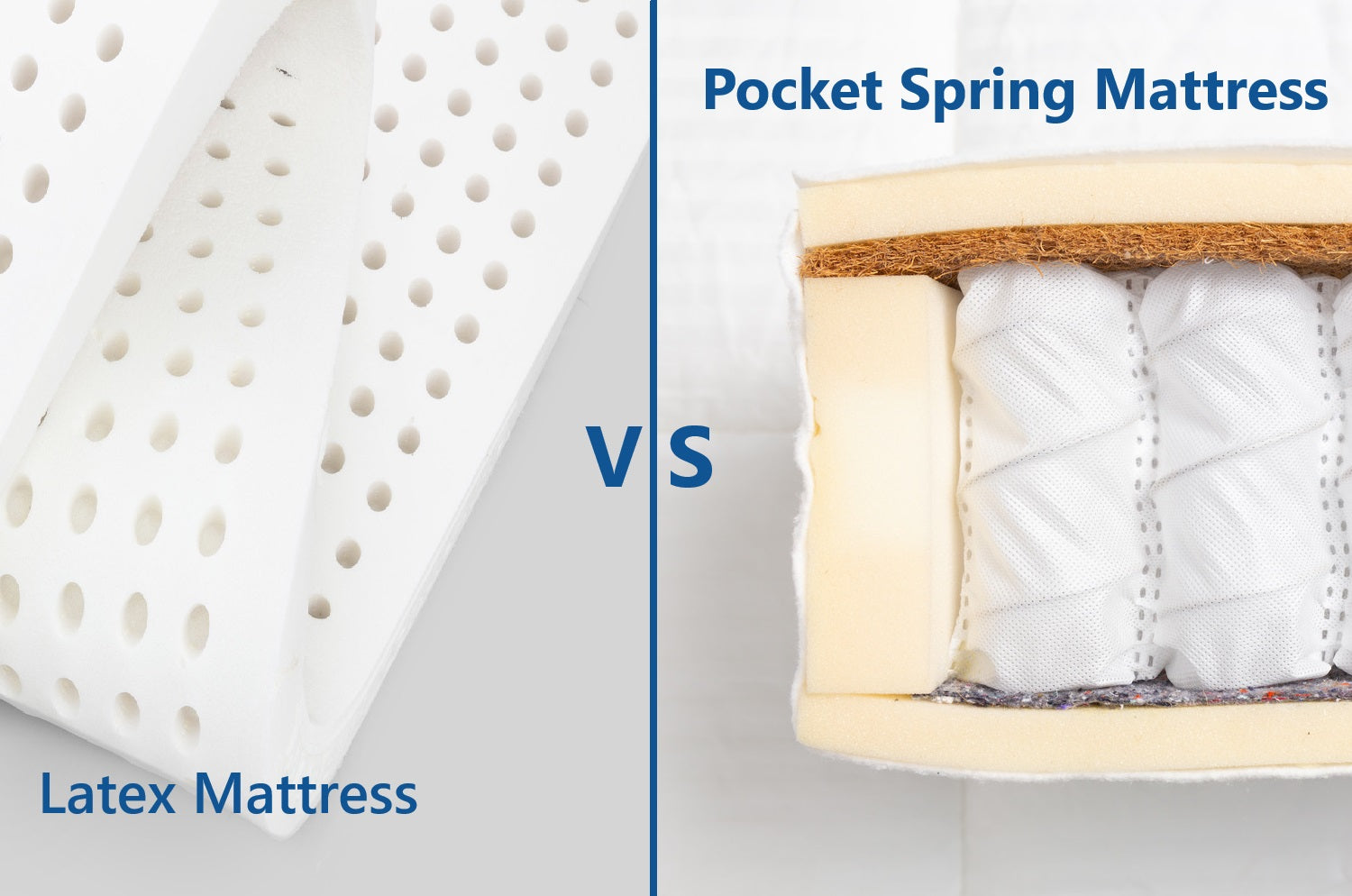If you’re shopping for a new mattress and unsure whether latex or memory foam is the better fit, you’re in the right place. In this post, we’ll break down the key differences between these two popular mattress types—focusing on comfort, support, and what you can expect.
Latex mattresses, made from either natural or synthetic materials, are renowned for their bouncy, responsive feel and ability to maintain a cool temperature throughout the night. Memory foam, on the other hand, excels at motion isolation and offers deep pressure relief by contouring to your body’s shape, making it especially appealing for side sleepers and couples.
We’ll also explore how each mattress type handles temperature, durability, and overall sleep experience, helping you decide which option will best match your needs and preferences in Cyprus.
What is a latex mattress?
A latex mattress is a type of mattress that uses latex foam—derived from either natural rubber tree sap or synthetic materials—as its primary support and comfort layer.
The latex used in these mattresses can be:
-
Natural latex, derived from the sap of rubber trees (Hevea brasiliensis), is renowned for its eco-friendly properties, breathability, and exceptional durability.
-
Synthetic latex, produced from petrochemicals to mimic the qualities of natural latex, generally offers a firmer feel at a lower cost but with less durability.
-
Blended latex combines both natural and synthetic latex to strike a balance between cost, performance, and feel.
Latex mattresses are valued for their resilience, responsiveness, and pressure relief. They contour to the body while maintaining a responsive, supportive feel, making movement easy and providing excellent spinal alignment. Natural latex, in particular, is highly breathable, hypoallergenic, and resistant to dust mites and mould, making it a popular choice for allergy sufferers and those seeking a healthier sleep environment.
Manufacturers use two main processes to produce latex foam: Dunlop, which creates a denser, firmer foam, and Talalay, which results in a lighter, softer, and more consistent foam. The choice between these affects the overall feel and firmness of the mattress.
What is a memory foam mattress?
A memory foam mattress is a type of mattress made primarily from viscoelastic polyurethane foam, commonly referred to as memory foam. This material is engineered to be both viscous and elastic, meaning it slowly responds to pressure and heat, allowing the mattress to contour closely to the shape of your body.
Memory foam mattresses typically consist of several layers:
-
Comfort layers are made from memory foam, which provides the signature “body-hugging” feel and excellent pressure relief.
-
The support core, made from high-density polyurethane foam, provides the mattress with stability and durability.
A memory foam mattress provides personalised contouring, effective motion isolation, and pressure relief, making it a popular choice for individuals seeking comfort and support tailored to their unique body shape.
What are the Differences Between Latex and Memory Foam Mattresses?
Latex mattresses have a good bounce. They also feel quick to respond with a faster response time when you lie down. Memory foam provides a soft feel that moulds to your shape and curves.
However, latex mattresses are usually cooler and allow air to move through more effectively than memory foam. Memory foam can get hot at times. Both types are designed for individuals who have their own unique sleeping patterns or specific nighttime needs.
1. Material Differences Between Latex and Memory Foam Mattresses
When it comes to materials, latex and memory foam mattresses differ fundamentally in both composition and performance.
Latex Mattresses:
-
Made from either natural latex (derived from rubber tree sap) or synthetic latex (petrochemical-based), and sometimes a blend of both.
-
Natural latex is produced using either the Dunlop or Talalay process, resulting in foam that is highly durable, elastic, and bouncy.
-
Latex has an open-cell structure, promoting breathability and a cooler sleep surface.
-
Known for being hypoallergenic and resistant to dust mites, mould, and bacteria, making it ideal for allergy sufferers.
-
Offers a responsive feel—it quickly adapts to your movements and provides a more “on the mattress” sensation.
Memory Foam Mattresses:
-
Constructed from viscoelastic polyurethane foam, a synthetic material developed initially for shock absorption.
-
Memory foam is dense and relies on body heat to mould and conform closely to your body, providing a deep, pressure-relieving “hug”.
-
The structure is typically a closed cell, which can trap heat. However, some models incorporate gel infusions or open-cell designs to improve breathability.
-
Memory foam excels at motion isolation and minimising partner disturbance. Still, it may be less breathable and can retain moisture and heat.
-
It is not naturally hypoallergenic; it can attract dust mites and allergens unless treated with antimicrobial additives.
Latex mattresses are made from natural or synthetic rubber and are characterised by their breathability, resilience, and hypoallergenic properties. In contrast, memory foam mattresses are made from synthetic foam that contours deeply but may retain heat and allergens.
2. Support Differences Between Latex and Memory Foam Mattresses
Support is a crucial factor when comparing latex and memory foam mattresses, as each material offers a distinct approach to comfort, body alignment, and pressure relief.
Latex Mattresses:
-
Responsive and responsive Support: Latex provides a naturally bouncy, springy support that quickly adapts to your movements. This responsiveness means the mattress supports your body evenly and springs back into shape as you change positions, making it ideal for combination sleepers or those who frequently move during the night.
-
Long-Term Support and Durability: Latex mattresses are known for retaining their supportive qualities over time. They resist sagging and maintain their shape and firmness for many years, offering consistent spinal alignment and comfort throughout their lifespan.
-
Targeted Spinal Alignment: Latex distributes weight evenly and provides targeted support to areas like the back and hips, helping to keep the spine properly aligned and reducing the risk of back pain.
-
Moderate Contouring: While latex does contour to your body, it does so less deeply than memory foam, offering a more “on the mattress” feel rather than a “sinking in” sensation.
Memory Foam Mattresses:
-
Deep Contouring and Pressure Relief: Memory foam excels at moulding your body’s shape, providing a cradling effect that relieves pressure on sensitive areas, such as the hips and shoulders. This makes it particularly beneficial for side sleepers and those with joint pain.
-
Personalised Support: The foam compresses under the heavier parts of the body and offers gentle support to lighter areas, promoting even weight distribution and maintaining healthy spinal alignment.
-
Motion Isolation: Memory foam’s slow response to movement effectively absorbs motion, minimising disturbances from a partner’s movements.
-
Potential for Sagging: Over time, memory foam may lose its resilience and begin to sag, which can reduce support and comfort, especially if the foam is low density or the mattress is not rotated regularly.
Edge Support:
-
Memory foam generally offers better edge support, making it more stable when sitting or lying near the edge of the bed.
-
Latex may feel less supportive at the edges, with some users experiencing a slight “rolling off” sensation.
Latex mattresses provide resilient, long-lasting support with a responsive feel. In contrast, memory foam mattresses excel at deep contouring and pressure relief but may lose support over time. Your choice should reflect your preferred sleeping style, need for pressure relief, and whether you value a more bouncy or cradling sleep surface.
3. Feel Differences Between Latex and Memory Foam Mattresses
The feel differences between latex and memory foam mattresses are among the most noticeable factors when choosing between these two types.
Memory Foam Mattresses:
-
Offer a deep, body-hugging feel—the foam slowly contours and adapts to your body’s exact shape, creating a pronounced “sinking in” sensation.
-
The material responds slowly to movement, meaning it gradually returns to its original form after you shift positions.
-
This slow response and close contouring provide excellent pressure relief. Still, they can create a “stuck” or enveloped feeling, especially for those who don’t move much at night.
-
Memory foam typically feels softer and gentler to the touch compared to latex.
Latex Mattresses:
-
Have a bouncy, responsive feel—latex quickly adapts to your movements and springs back immediately when you change positions.
-
The contouring is more generalised rather than precise; you’ll feel supported but more “on top” of the mattress rather than “in” it.
-
Latex’s fast response time and elasticity make it easier to move around and prevent the sinking feeling familiar with memory foam.
-
Latex is generally firmer and more bouncy than memory foam, providing a lifted sensation rather than a deep hug.
Choose memory foam if you prefer a plush, contouring, slow-responding mattress that hugs your body. Opt for latex if you want a firmer, more responsive, and bouncier feel that keeps you lifted and makes movement effortless.
4. Allergy Suitability Differences Between Latex and Memory Foam Mattresses
When it comes to allergy suitability, latex and memory foam mattresses differ significantly in their impact on individuals with allergies.
Latex Mattresses:
-
Naturally hypoallergenic: Latex mattresses, especially those made from natural latex, are inherently resistant to dust mites, mould, mildew, and bacteria. This makes them an excellent choice for people with allergies, asthma, or sensitivities to indoor allergens.
-
Chemical-free comfort: Natural latex is free from many of the chemicals and volatile organic compounds (VOCs) found in synthetic foams, reducing the risk of chemical sensitivities.
-
Antimicrobial and breathable: The open-cell structure of latex enhances breathability and moisture control, further discouraging the buildup of allergens.
-
Latex allergies: True latex allergies are rare, and most latex mattresses undergo washing processes that remove proteins that can trigger allergies. However, those with severe latex allergies should still exercise caution or consider synthetic latex alternatives.
Memory Foam Mattresses:
-
Synthetic and dense: Memory foam is made from viscoelastic polyurethane. This synthetic material is generally safe for those with latex allergies.
-
Potential for chemical sensitivity: New memory foam mattresses can emit a chemical odour (off-gassing) from VOCs, which may cause irritation or allergic reactions in sensitive individuals.
-
Allergen accumulation: While memory foam’s dense structure can help keep out dust mites and some allergens, it can also trap heat and moisture, creating an environment where allergens may thrive if not correctly maintained.
-
Hypoallergenic options: Some memory foam mattresses are treated to be hypoallergenic, but reactions to chemicals or odours are still possible, especially for those with respiratory issues or sensitivities.
Natural latex mattresses are generally the best choice for allergy sufferers due to their inherent resistance to common allergens and the absence of harsh chemicals. Memory foam can be a suitable option, especially for individuals with latex allergies. Still, it may cause issues for people sensitive to chemical odours or prone to respiratory allergies.
5. Pressure Relief Differences Between Latex and Memory Foam Mattresses
When it comes to pressure relief, latex and memory foam mattresses both offer significant benefits. Still, they achieve this in different ways and with distinct sensations.
Memory Foam Mattresses:
-
Superior Contouring: Memory foam is renowned for its deep, body-hugging contour. It slowly molds to your unique shape, distributing weight evenly and minimising pressure on sensitive areas, such as the shoulders, hips, and lower back.
-
Targeted Pressure Point Relief: This close-conforming effect is especially beneficial for side sleepers and individuals with joint pain or arthritis, as it helps reduce discomfort and supports proper spinal alignment.
-
“Sinking In” Sensation: The foam’s slow response creates a cradling, almost “cocoon-like” feel, which some sleepers find soothing but others may find restrictive if they change positions frequently.
Latex Mattresses:
-
Balanced Pressure Relief and Support: Latex provides pressure relief by gently conforming to the body, offering a more generalised, responsive support rather than a deep hug. This helps distribute weight evenly and reduces pressure points, especially around the hips and shoulders.
-
Responsive and Lifting Feel: Unlike memory foam, latex quickly adapts to movement, maintaining support without excessive sinking. This makes it easier to change positions and prevents the “stuck” feeling.
-
Spinal Alignment: The natural elasticity of latex helps maintain spinal alignment, which can reduce back pain and improve overall sleep quality.
Choose memory foam if you want deep, personalised pressure relief and a contouring feel. Opt for latex if you prefer a more responsive, responsive mattress that still relieves pressure while allowing for more effortless movement and maintaining spinal alignment.
6. Temperature Regulation Differences Between Latex and Memory Foam Mattresses
Temperature regulation is one of the most significant differences between latex and memory foam mattresses, particularly for individuals who tend to sleep hot or reside in warm climates, such as Cyprus.
Latex Mattresses:
-
Superior breathability: Latex mattresses, especially those made from natural latex, have an open-cell structure and often include pinholes or aeration channels. This design allows for excellent airflow, which helps dissipate heat and moisture away from the body.
-
Naturally cooling: Latex is a temperature-neutral material and does not trap heat. Its moisture-wicking properties further enhance its ability to keep sleepers cool and dry throughout the night.
-
Consistent comfort: The responsive nature of latex prevents heat from accumulating in one area, maintaining a stable and comfortable sleep surface.
Memory Foam Mattresses:
-
Heat retention: Traditional memory foam is known for absorbing and trapping body heat due to its dense, closed-cell structure. This can make memory foam mattresses feel uncomfortably warm, particularly for hot sleepers or during summer months.
-
Cooling technologies: Some modern memory foam mattresses incorporate cooling gels, open-cell designs, or phase-change materials to help reduce heat buildup. While these features can enhance temperature regulation, they often fail to match the natural cooling properties of latex.
-
Body contouring and warmth: Memory foam’s close contouring can create a cocoon-like effect that further traps heat against the sleeper’s body.
Latex mattresses offer much better temperature regulation and breathability than memory foam mattresses. If you are sensitive to heat or want a cooler sleep experience, latex is the superior choice.
7. Best-Use Differences Between Latex and Pocket Spring Mattresses
When deciding between latex and pocket spring mattresses, it’s important to consider how each type performs in different situations and which sleepers benefit most from their unique features.
Here’s a breakdown of their best-use cases based on construction, comfort, support, durability, and other key factors:
|
Mattress Type |
Best Use Cases |
Key Benefits |
Potential Drawbacks |
|---|---|---|---|
|
Latex Mattress |
- Sleepers seeking long-term durability |
- Exceptional durability (10–15+ years) |
- Higher upfront cost |
|
Pocket Spring Mattress |
- Sleepers preferring a more traditional, bouncy feel |
- Good airflow and breathability |
- Shorter lifespan (7–10 years) |
Your final choice should reflect your personal comfort preferences, sleep needs, and long-term expectations of your mattress.



